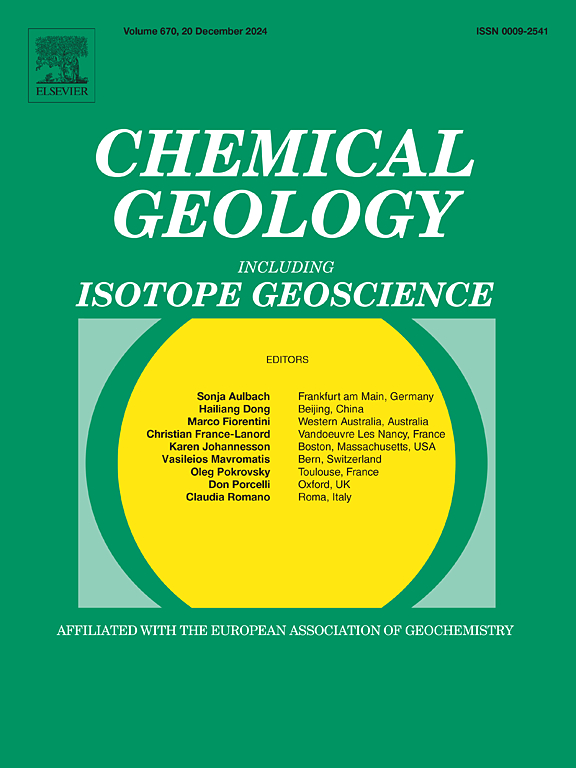钼同位素记录了东北晚三叠世弧熔岩地幔源的板块输入
IF 3.6
2区 地球科学
Q1 GEOCHEMISTRY & GEOPHYSICS
引用次数: 0
摘要
弧熔岩地球化学研究为俯冲带深部地幔板块输入的勘探提供了一个重要的窗口。然而,俯冲成分的分类和到达地幔的贡献程度难以直接观测,对这种再循环机制的认识仍然很差。本文报道了中国东北晚三叠世基性岩石的Mo-Sr-Nd-Hf同位素数据,这些岩石是早中生代蒙古-鄂霍次克洋板块俯冲的产物。它们的δ98/95Mo值为- 0.24‰~ 0.36‰,大多高于正常地幔值- 0.20‰±0.01‰。这些岩石的微量元素组成呈弧形,全岩Sr-Nd-Hf同位素呈贫态,(87Sr/86Sr)i比值为0.7039 ~ 0.7043,εNd(t)值为4.0 ~ 8.5,εHf(t)值为6.9 ~ 11.1。锆石εHf(t)值偏高,为7.7 ~ 12.7。结合较高的La/Sm、Th/La、Ba/La和Ba/Th比值,表明弧岩中的重Mo同位素特征主要继承自蚀变洋壳源水溶液和少量缺氧沉积源熔体。因此,基性火成岩Mo-Sr-Nd-Hf联合同位素研究是追踪俯冲带地球化学通量的有力手段,特别是钼同位素系统的研究为研究汇聚板块边缘地壳物质的再循环提供了新的思路。本文章由计算机程序翻译,如有差异,请以英文原文为准。
Molybdenum isotopes record slab inputs to the mantle source of late Triassic Arc Lavas, Northeast China
The geochemical study of arc lavas provides an important window for the exploration of slab input into deep mantle in subduction zones. However, the classification of subduction compositions and the contribution degree that reaches the mantle are difficult to observe directly, and this recycling mechanism is still poorly understood. Here we report Mo-Sr-Nd-Hf isotope data for Late Triassic mafic rocks from Northeast China, which were products of Mongol–Okhotsk Ocean slab subduction in the Early Mesozoic. They have δ98/95Mo values of −0.24 ‰ to 0.36 ‰, which are mostly higher than the normal mantle value of −0.20 ‰ ± 0.01 ‰. These rocks also exhibit arc-like trace element compositions and depleted whole-rock Sr-Nd-Hf isotopes, with (87Sr/86Sr)i ratios of 0.7039 to 0.7043, εNd(t) values of 4.0 to 8.5 and εHf(t) values of 6.9 to 11.1. In addition, they also have elevated zircon εHf(t) values of 7.7 to 12.7. These features, combined with high La/Sm, Th/La, Ba/La, and Ba/Th ratios, suggest that the heavy Mo isotope signatures in the arc rocks were mainly inherited from altered oceanic crust-derived aqueous solutions with minor anoxic sediment-derived melts. Therefore, the combined Mo-Sr-Nd-Hf isotopic studies in mafic igneous rocks are a powerful means to trace the geochemical fluxes in subduction zones, especially with the studies of molybdenum isotope system providing new insights into the recycling of crustal materials at the convergence plate margin.
求助全文
通过发布文献求助,成功后即可免费获取论文全文。
去求助
来源期刊

Chemical Geology
地学-地球化学与地球物理
CiteScore
7.20
自引率
10.30%
发文量
374
审稿时长
3.6 months
期刊介绍:
Chemical Geology is an international journal that publishes original research papers on isotopic and elemental geochemistry, geochronology and cosmochemistry.
The Journal focuses on chemical processes in igneous, metamorphic, and sedimentary petrology, low- and high-temperature aqueous solutions, biogeochemistry, the environment and cosmochemistry.
Papers that are field, experimentally, or computationally based are appropriate if they are of broad international interest. The Journal generally does not publish papers that are primarily of regional or local interest, or which are primarily focused on remediation and applied geochemistry.
The Journal also welcomes innovative papers dealing with significant analytical advances that are of wide interest in the community and extend significantly beyond the scope of what would be included in the methods section of a standard research paper.
 求助内容:
求助内容: 应助结果提醒方式:
应助结果提醒方式:


